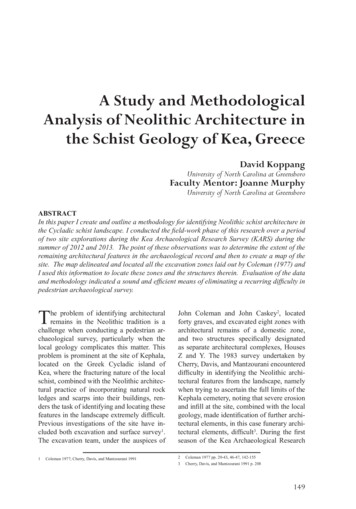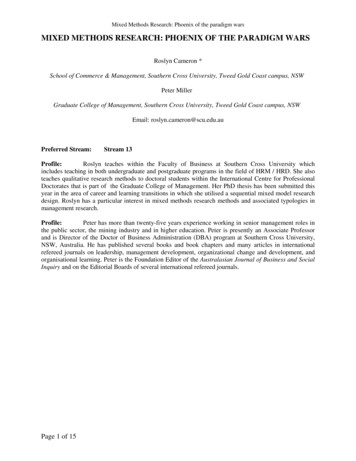
Transcription
A Study and MethodologicalAnalysis of Neolithic Architecture inthe Schist Geology of Kea, GreeceDavid KoppangUniversity of North Carolina at GreensboroFaculty Mentor: Joanne MurphyUniversity of North Carolina at GreensboroABSTRACTIn this paper I create and outline a methodology for identifying Neolithic schist architecture inthe Cycladic schist landscape. I conducted the field-work phase of this research over a periodof two site explorations during the Kea Archaeological Research Survey (KARS) during thesummer of 2012 and 2013. The point of these observations was to determine the extent of theremaining architectural features in the archaeological record and then to create a map of thesite. The map delineated and located all the excavation zones laid out by Coleman (1977) andI used this information to locate these zones and the structures therein. Evaluation of the dataand methodology indicated a sound and efficient means of eliminating a recurring difficulty inpedestrian archaeological survey.The problem of identifying architecturalremains in the Neolithic tradition is achallenge when conducting a pedestrian archaeological survey, particularly when thelocal geology complicates this matter. Thisproblem is prominent at the site of Kephala,located on the Greek Cycladic island ofKea, where the fracturing nature of the localschist, combined with the Neolithic architectural practice of incorporating natural rockledges and scarps into their buildings, renders the task of identifying and locating thesefeatures in the landscape extremely difficult.Previous investigations of the site have included both excavation and surface survey1.The excavation team, under the auspices ofJohn Coleman and John Caskey2, locatedforty graves, and excavated eight zones witharchitectural remains of a domestic zone,and two structures specifically designatedas separate architectural complexes, HousesZ and Y. The 1983 survey undertaken byCherry, Davis, and Mantzourani encountereddifficulty in identifying the Neolithic architectural features from the landscape, namelywhen trying to ascertain the full limits of theKephala cemetery, noting that severe erosionand infill at the site, combined with the localgeology, made identification of further architectural elements, in this case funerary architectural elements, difficult3. During the firstseason of the Kea Archaeological Research123Coleman 1977; Cherry, Davis, and Mantzourani 1991Coleman 1977 pp. 20-43, 46-47, 142-155Cherry, Davis, and Mantzourani 1991 p. 208149
Explorations Social SciencesSurvey (hereafter referred to as KARS) anintensive gridded survey collection was conducted on this site, during which the problematic nature of identifying architecturalelements was again noted. The survey resultsin this matter proved to be inconclusive, andthe 1977 Coleman findings4 remain thus unchallenged in this regard.The goal I am pursuing in this paper is to create and outline amethodology for identifying Neolithic schistarchitecture in the Cycladic schist landscape.In the course of this paper I will outline whatis to be accomplished by the creation of thismethodology and its role in pedestrian archaeological survey as a means of alleviatingthe difficulties in this arena. To illustrate boththe need for a methodology and how it willbenefit archaeological research in the regionI will explain the nature of the problem presented by the native geology and architecturaltradition. From there I will present my methods and their application in the field, and willthen present an evaluation of the data gathered from the Kephala investigations and theconclusions that can be drawn to amelioratethe task of discerning Neolithic architecturalelements in a Cycladic schist geomorph.ObjectiveThe primary objective of this researchproject was to establish a method for distinguishing Neolithic architectural elements,which I define in my research as any anthropogenic alteration of the landscape forthe purposes of construction and any humanmade structures and structural elements,from naturally occurring changes or features within the schist geology of the islandof Kea. While the research conducted dealsspecifically with the island of Kea, the geology of the Cyclades is such that methodologies established on Kea can, within reason,be transposed to other Cycladic landscapes.The types of site targeted by the methodology under development are semi-exposedarchitectural sites near the surface, where the4150Coleman 1977remains are visible for analysis, as this is asurvey-based methodology. As Kephala isboth partially exposed and a previously excavated Neolithic architectural site, it provedto be an ideal testing ground for the development of an architectural identification methodology. The fact that the site was previouslyexcavated presented a unique challenge, inthat questions of the efficacy of the resulting methodology could be raised, for howcan one test an identification methodologyon a pre-excavated site? The alternative,finding a new Neolithic architectural site,however, was neither practical nor feasible.At any rate, the concerns raised by the use ofKephala are addressed in the first phase of investigation.To understand the gravity of thisproblem, one must first become acquaintedwith both the nature of Cycladic Neolithicarchitecture, and the schist geomorph ofKea. The island of Kea is located in the AtticCycladic Crystalline Complex, in the portion known as the Cycladic Blueschist Unit(CBU). The CBU covers the southern tips ofAttica (Lavrion) and Euboea (Karistos), aswell as the islands of Kea, Kythnos, Sifnos,Ios, Delos, Naxos, Andros, Sikinos, Tinos,Antiparos, Serifos, and Tinos5. The geological unit is, as the name would suggest, defined by the predominance of schist as theprimary bedrock. This is, however, not theonly rock present, as is made apparent by thepresence of the large limestone outcrop at thesite of Paouras on the northern shore of Kea.Explanation of ProblemThe predominant form of schist present onKea is mica-schist, so named for the presence of the mineral mica within the structure of the schist. The presence of mica iswhat gives the schist its signature cleavingbehavior, wherein the schist breaks alongplanes established by the presence and positioning of the mica crystal flakes withinthe layers which comprise the schist6. Thesefractures, or cleavage, are largely tabular in56Bröcker and Pidgeon, 2007, Higgins and Higgins, 1996Higgins and Higgins 1996
David Koppangnature, resulting in the creation of slabs ofschist which can be of regular or irregulargeometric shape (here regular is defined asclearly identifiable rectangular forms). TheNeolithic builders working at Kephala wouldhave found this phenomena to be very muchto their advantage, and would have likely exploited this in the construction of their dwellings and tombs. The problem presented hereis that owing to the natural geometric cleavage pattern of the local schist, differentiatingbetween naturally cloven schist, and schistthat has been cloven and placed by humanactivity, is a rather problematic task. Shortof encountering an intact wall foundation, itproves rather difficult to determine what isthe exposed top of a wall unit, and what isa semi-exposed schist outcrop that has beencloven by natural forces so as to appear as aline of schist masonry. The matter is furthercomplicated by the fact that the masonry atthe site of Kephala does not appear to havebeen dressed in any fashion, aside from possibly reshaping some of the more irregularblocks. That said, even this is not readilydistinguishable from the natural cleaving ofthe schist. The following figures illustrate thepertinent issues associated with the fracturepatterns of schist.Figure 1 demonstrates how even whenFigure 1 A Kean schist slab naturally broken from an exposed outcrop. Notethe regularity of the slab geometry and the clean lines of the break. (Photoby author)Figure 2 A naturally cloven Kean schist slab. Note the regularity withwhich it has been cloven from the outcrop and the evenness of thebreak. (Photo by author)cloven by natural forces, schist will break in areasonably uniform and slab-like formation,separating both perpendicularly and parallelto the main outcrop, illustrating the tendencyof the schist to cleave in a planar formation.This is due to the presence of mica withinthe crystalline structure of schist. It shouldbe noted that though the example in Figure1 was found in a natural setting, it is by nomeans definitively indicative of all patternsof schist fracture, and in many instances ofschist architecture the edges of the slabs varyin degrees of roughness, from mildly roughto quite jagged in appearance and touch.Figure 2 illustrates the fairly smooth qualityof a natural cleaving. As seen in the figure,schist breaks along relatively straight lines,much like worked stone, which is illustratedin Figure 3. The slabs in Figure 3 bear a striking resemblance to the naturally cloven slabin Figures 1 and 2.Figure 3 A schist wall at Kephala. Note the irregularity in size,as well as the similarities between the slab in Figures 1 and 2and the slabs composing the wall. Also of note is the presenceof marble and limestone in the wall construction, as well as thecolor variations in the schist. (Photo by author)151
Explorations Social SciencesThese figures illustrate the fact that, at leastwhere the Kean Neolithic architectural practice is concerned, there appears to be little tono difference between schist that has brokenaway naturally and that which has been extracted from the landscape by the builders ofKephala. This ambiguity continues into themodern period, where in the course of myfield research I noted that the local farmersconstruct their pens and retaining walls using the same methods, and like the inhabitants of Kephala do not appear to dress theirmasonry.7 These walls vary in terms of energy expended, but consistently show thehallmarks of scavenged masonry, namelythe lack of dressing and the noted absence ofanything that could be definitively describedas a quarry. This adds another dimension tothe complication of identifying architecturein the landscape as there appears to be noevidence that the schist is worked.One avenue that I had considered in thecourse of my research was the weatheringrate of the schist, or rather to look for differences in weathering between potentiallyworked schist and the schist still resting insitu. Such investigations are, unfortunately,not wholly viable options. The reality is thatthe schist in the exposed masonry at Kephala,and that which has broken naturally from thebedrock, namely from the various exposedoutcrops and ledges, has been exposed to theelements since the formation of the islanditself. Obviously material below the surfacewill weather at a lesser rate, however the focus of this methodological investigation ison sites that are exposed on the surface, butrendered ambiguous by architectural tradition and landscape. A stone protruding fromthe ground and a stone lodged in a wall willexperience the same exposure to the elementsand thus display a similar weathering pattern.It should be noted again that there was nothing in the literature or material to suggest thatbuilding material was extracted from beneaththe soil level, therefore it is only these outcrops and cliff faces with which this research7152For a fuller discussion of modern Kean architectural practice see thechapters in Cherry, Davis, and Mantzourani 1991 pp. 351-454is concerned. This is not to say that weathering analysis should be totally discarded, butrather that in this particular scenario it wouldbe of little use. As Coleman8 notes in hispublication on the excavations at Kephala,the site as a whole is in a poor state of preservation, with much of the extant architectural remains showing signs of extensivewear from the local environment and gravity. Weathering analysis could potentiallybe applied to investigation of hypotheticalschist quarrying sites, here understood to besurface extraction sites, as opposed to traditional methods of quarrying which dig below the surface and are highly intensive andinvasive operations. A potential quarry sitewould be indicated by a decisive differencein the weathering of the schist, as the schistexposed by quarrying activities would nothave been exposed for the same duration asthe surface schist. Weathering in rocks can bedetected by splitting the rock in half, lookingfor “weathering rinds”, a phenomena causedby changes in the structural integrity and appearance of the rock as a result of weathering, and which appears as a noticeable ringlike surface layer. In this scenario mechanicalweathering tests can be conducted with metalprobes to test the strength and integrity of therock, and from there a numeric scale can bedeveloped based on observations from thistesting, as well as outward appearance of therock9. Given that the majority of the schistappears to have been scavenged or priedfrom crumbling outcrops, however, the existence of dedicated quarrying sites is up fordebate. At any rate, processes such as this, orcosmogenic ray analysis, which would bestdefinitively date the rock, are prohibitivelyexpensive in terms of energy and cost forwhat is being analyzed.MethodologyI conducted the field-work phase of this research over a period of two site explorationsduring the Kea Archaeological ResearchSurvey (KARS) during the summer of 201289Coleman 1977 p. 2Goudie 1981 pp.152-153
David KoppangFigure 4 A general plan of Kephala (Coleman 1977)and 2013. The point of these observationswas to determine first the extent of the remaining architectural features in the archaeological record. Because the site of Kephalahad last been excavated in the 1970’s, withno documented attempts at further conservation since that time, there were seriousquestions about the level of preservation atthe site and if it would be possible to identify the site’s various elements and structures.During the first excavations 40 years ago, thesite of Kephala was determined to be in arelatively poor state of overall preservation10and during KARS operations in 2012, whichconsisted of an intensive, surface, surveycollection and description of the cultural remains, as well as my own investigations, thesite showed signs of collapse and refilling ofthe excavation zones. Knowing how poorlypreserved the site was, I developed a methodology that would allow me to differentiatebetween unworked and worked schist slabsand to ascertain which were more likely tohave been incorporated into structures.Phase One of the investigation was to conduct an intensive architecturally focused survey on the site without the assistance of maps10Coleman 1977 p. 2or research aids. By proceeding without theseresources, an unbiased analysis was madepossible. The main purpose of the PhaseOne operation was to determine what wouldbe immediately architecturally identifiablefrom the landscape of the site, as well as howthe local geomorph impacted what could beseen. As this is a survey oriented methodology, the primary focus and research methodswill heavily involve the human eye, namelywhat is visible to a field observer and how toaid that observer in the interpretation of thematerial data they are viewing in the field. Inthe 1983 survey, the problem of discrepancies in survey walker observation skills wasconsidered, but was not found to be of significant detriment, with Whitelaw noting inhis chapter on the investigations of Kephalathat it did not cause significant fluctuationsin the data11. Obviously a more attentivewalker will have an easier time of detectingthe sometimes subtle differences that contrastNeolithic schist architecture from the nativegeology; however, the methodology I developed in my research is primarily focused onthe field walker whose powers of observationfall in the average skill level. What is meant11Cherry, Davis, and Mantzourani 1991 p. 202153
Explorations Social Scienceshere is that such a walker can easily discernsurface artifacts such as chipped stone andpottery, but may experience significant difficulty in separating Neolithic schist architecture from the surrounding schist geology, aswas the case during the intensive grid pickupduring the 2012 season, where many of thesurvey walkers were students experiencing archaeological material in its raw nativecontext for the first time. It is important tonote, however, that though the problem washighlighted during this season of the KARSendeavor, the problem has manifested itselfin earlier investigations, and is not uniqueto the nature of utilizing student field schoolresearchers. The objective was to see whatcould be picked out of the landscape by anobserver, and what could be firmly and readily identified as architecture. This initial unaided observation was important in that itwould determine first of all what the baselinecapacity for the detection of architectural elements in the Kean landscape is for the average survey walker, and secondly establish acomparison point for the data obtained in thesecond phase of research.An important goal of Phase Two was tofirst create a map of the site, delineating andfirmly locating all the excavation zones laidout by Coleman, which would then be used tolocate these zones and the structures therein.By surveying the site a second time and focusing on the excavation zones, the observations made in the Phase One operation couldbe either verified or refuted. Phase Two of research made extensive use of the free GoogleEarth application and the Coleman publication12. These diagrams were extracted intoGIMP (Gnu Image Manipulation Program),a freeware image editing and manipulationprogram, and used as temporary guide layersin Google Earth to trace the overall layout ofthe site as dictated by Coleman’s maps. Thiswas done to have a properly oriented framefor the second step, which was to trace thelocations of the excavation zones, and fromthere to trace the individual structural layout12154Coleman 1977of the architectural remains documented byColeman. By doing so a complete map of thesite combining both the structures and excavation zones with satellite imagery was created. The reasons for the creation of this mapwere largely those of accuracy in terms ofidentification, as well as to contextualize anypotentially new discoveries in the landscapeof Kephala.After mapping the site and the architecturalfeatures therein, I proceeded to the site to begin examining the excavation zones themselves. The location of these was now madeclear, allowing for a comparison of observation of these zones pre, and post knowledge.By examining the zones in the wake of thePhase One operation, vital questions could beasked: What was still not being seen? Whathad been seen during the secondary runs thathad not been seen in the Phase One investigation? Why had the material seen duringthe secondary runs not been seen during thePhase One investigation? These questionsalso led into inquiries into the nature of thearchitecture at Kephala. What do all thesearchitectural elements have in common todistinguish themselves from the local rock?How have the natural forces of time, nature,and the landscape impacted the remains? Alsoof importance is the question of how these architectural elements correlate to the ceramicand lithic densities observed in the courseof investigations of the site. To be sure, thevolume of questions raised did indeed appearquite daunting. The methodological modelwas put in place to ensure that sufficient datacould be generated to answer these questions,or at the very least begin asking the properquestions to tackle the main questions.Observations and ConclusionsThe Phase One investigation of the sitewas concluded in fairly short order. The siteof Kephala measures approximately 275 meters in length from east to west, and, at itswidest, from north to south approximately150 meters in width. The primary target area
David Koppangwas the south slope, where the Coleman excavation zones were located, and where thesite was most accessible for large scale exploration. Owing to the highly interpretivenature of the project I did most of the walkingmyself, mainly for the sake of consistency,although student observers were includedfor purposes of instruction and observation.The Phase One operation took place at approximately 12:00 PM Hellenic time on June23, 2010, and continued until approximately3:30 PM. During that time the entirety of thesouth slope was examined. In this initial investigation identifications were extremelytentative. The area of Zone G from theColeman excavation13 was located; however,this was one of the more prominent featuresof the site, comprised of a wall situated ona rock ledge above the spine of the Kephalaisthmus. As such this identification must betaken for what it is, the observance of a salient archaeological element, and therefore isnot a major accomplishment in terms of observation. Beyond this first zone identification there was little else which was positivelyidentifiable, as was suspected.After the initial walking of the south slope,an attempt was made to locate a questionable feature from the first year of the KARSproject; a schist slab embedded in the hillsideat a roughly 90 degree angle. While this feature has been documented in the prior year’sresearch notes, as well as photographed, inlight of both its qualities and location, thisparticular feature was specifically targeted asbeing relevant to this research endeavor. It isunfortunate then that during the course of theblind run, and subsequent runs, the featurewas unable to be relocated. It is my opinionthat this feature, having been partially covered by a patch of vegetation overgrowthwhen it was first noted, may have been enveloped by said overgrowth, or else the sameforces which have served to deteriorate thesite have perhaps carried it away, as its position did indeed seem somewhat precarious.In the course of the Phase Two operations13Coleman 1977 Plate 6on the site (June 30th and July 7th respectively), Excavation Zones D, L, and F werelocated and the surrounding area of thesezones examined as well. These investigationsproceeded in a straightforward manner owingto the utilization of the mapping data generated for this project, and the excavation zoneswere located quickly and efficiently. Becausemap data were utilized, the Phase Two operations on the site were targeted to specificareas. The first Phase Two operation focusedon the area around Zone D, as research conducted after the Phase One operation indicated a heavy architectural presence in thatparticular zone.14 Because of the density ofarchitectural material located in this zone byColeman, it was decided that this would bewhere the primary observations on the natureof Kean Neolithic Schist architecture wouldbe made. Upon approaching Zone D, it wasreadily apparent why it had escaped noticeduring the blind run. While fairly exposed,the structure was very much integrated intothe landscape, and partially obscured by vegetation. In what is posited to be the interiorof the structure, a concentrated growth ofballota acetabulosa sits atop a wall which, atfirst glance appears to be a naturally fracturedschist rock. Its positioning relative to thereadily distinguished architectural elements,however, suggested otherwise, and this wasconfirmed by consultation with both the mapand the Kephala publication.This brings us to item number one in themethodological corollary which has resultedthus far: architectural elements can potentiallybe identified by proximity to other architectural elements. Not just in Zone D, but acrossthe site’s excavation zones, it was found thatin the majority of cases where a suspect rockformation was observed in close proximity toreadily apparent architectural remains, saidformation was found to have been a plottedarchitectural feature in the Coleman report.Again, this emphasizes the importance of thePhase One operation, as well as the decisionto use a previously identified Neolithic site.14Coleman 1977 Plate 4155
Explorations Social SciencesSpecific example aside, several recurringtrends were observed in the architectural dataof Kephala. One overarching theme throughout the observations made of the architectureat Kephala is the use of thick slabs of schistand occasionally limestone, although thiswas observed only in limited quantities, andis confirmed by Coleman15. Contrary to otherexamples of Neolithic architecture, particularly on the mainland, there appears to be noevidence of the use of mudbrick, and as suchis must be assumed that the entirety of theKephalan structures was schist drystone masonry, with the roofs being either schist slabsor less durable material such as clay, reeds,or timber. The slabs in the retaining walls inparticular are of a thicker, sturdier order thanthose used to cover a wall which is cut intothe hillside, such as at Zone L. Zone L is interesting in that in addition to being cut intothe hillside, it also makes use of a limestoneslab approximately 40-43 cm. long set into aniche located in the center of the north wallof the structure.This item, in addition to the observationthat multiple varieties of schist beyond thelocal green are present in abundance, suggests that perhaps the Kephalans looked tosources outside their locality for buildingmaterials. This would not be surprising as itwould appear that constant exposure to saltwater does not have a beneficial effect on thestructural integrity of schist, although furtherresearch would be needed to establish this asa genuine absolute. Therefore architecturalelements can potentially be distinguished bymarked difference in the stone from the localgeology, even if the difference is more superficial in nature. The reasoning for this couldbe superiority of strength, perhaps a desirenot to gouge out their own land, which mightbe better suited to other activities, or perhapsas simple as aesthetic taste and prestige. ForKephala, I would venture to say that it was amatter of integrity of materials, owing to theobserved, and very marked, fragility of thelocal schist, which I would again attribute to1516Coleman 1977Coleman 1977 pp/ 1-3156the corrosive action of salt water from wavesand particles in the air.With the statement of this corollary, thequestion remains, “Does it work?” For thequestion of efficacy I can only point to arather small discovery, but a discovery nonetheless. In the space between Zones L and F,a series of stones was observed running in aline from east to west, towards Zone F. Uponfurther examination, these stones were foundto connect to exposed patches of walls, andmore importantly that these stones were uniform in their path of “travel” so-to-speak, andwere markedly different from the local greenschist. Initial notions that this might havebeen a sheep wall were dispelled when it waspointed out that such structures, once land ispurchased for clearance and excavation, areremoved. It also bears mentioning that thewall in question connects two archaeologically validated structures. It is my opiniontherefore, that this wall is perhaps a Neolithicretaining wall, given that it abuts the slopeof the hill and follows its contours. In hisopening description of the site of Kephala,Coleman notes that it appears that much ofthe terracing (which Coleman posits to havebeen the means by which the settlement wassituated on the slopes of the headland) whichsupported the settlement appears to have beenswept away by the gravity and the forces oferosion16, leading me to suspect that this wallmay be the remnants of such terracing.To conclude, though the Kean/Cycladiclandscape presents unique challenges to archaeological investigation, when approachedand probed methodically, solutions can befound. It is my profound hope that the efforts presented here are of use to those whowill follow behind me. Survey archaeologypresents its own unique challenges, of whichthose addressed in this research are a part.Through thorough analysis of the Neolithicsite of Kephala and consultation of prior investigations, the framework of a methodology was created. This was then further developed through research and exploration of
David Koppangboth the nature of the Cycladic schist landscape, in particular as it presents on Kea,and the nature of the Neolithic builders atKephala, and thereby ostensibly across Kea.The methodology I have delineated here represents what my research has revealed to bea sound and efficient means of eliminatinga recurring difficulty in pedestrian archaeological survey.AcknowledgementsI would like to close this report on myresearch findings first and foremost with astatement of thanks for the assistance rendered to me by the staff and students of theKea Archaeological Research Survey, inparticular the tireless support of Dr. JoanneMurphy of the University of North Carolinaat Greensboro, Giannakis Timotheou of theGreek Department of Antiquities and CiaránMurphy, whose dedicated support of both myresearch and the KARS project is worthy ofgreat praise, Dora Lambert, whose assistancewith the mapping portion of my research isgreatly appreciated, Margarita Nazou, whoseexpertise on the Neolithic period and Kephalawas of considerable help, and Caolán MacAn Aircinn of Trinity College Dublin andAshley Rutkoski of the University of Akron,whose sincere interest in, and participation inmy research cannot be appreciated enough.Additional thanks must be expressed to thestaff of the Kea Archaeological ResearchSurvey (KARS). My success in this projectis thanks in no small part to their efforts andsupport.157
Explorations Social SciencesWorks CitedBröcker, M. and R.T. Pidgeon.2007 Protolith ages of meta-igneous and meta-tuffaceous rocks from the Cycladicblueschist unit, Greece: results of a reconnaissance U-Pb zircon study. Journal ofGeology, 115, 83-98.Burn, A.R. and Mary Burn1980 The Living Past of Greece. L
Antiparos, Serifos, and Tinos5. The geologi-cal unit is, as the name would suggest, de-fined by the predominance of schist as the primary bedrock. This is, however, not the only rock present, as is made apparent by the presence of the large limestone outcrop at the site of Paouras on the northern shore of Kea. Explanation of Problem










